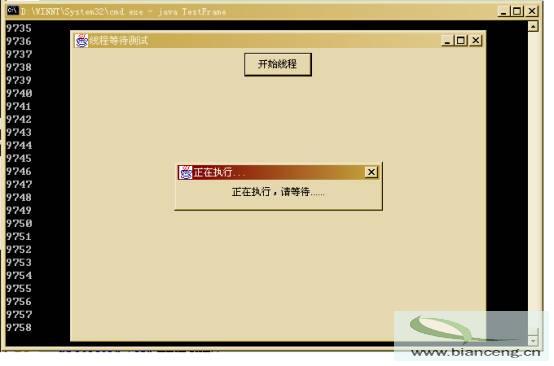Java語言從其誕生到現在不過短短五年時間,卻已經成為全球最熱門的語言,Java程序員正成為IT業其它程序員中薪金最高的職員。這一切都應歸功於Java良好的特性:簡單、面向對象、分布式、平台無關性、可移植性、支持多線程等等。本文將用Java的多線程特性來實現線程等待提示框。
1 問題的提出
在Java應用程序編程中,有時需要在GUI(圖形化用戶界面)中處理一些占用系統資源較多,耗費時間較長的事務,例如:與數據庫進行大批量數據交換、大數據量的復雜運算、遠程連接服務器等等。系統在處理這些事務時,如果還是使用GUI所在的線程,會導致界面凍結,無法刷新,看起來好象系統已經崩潰,這是一個良好的軟件系統不允許出現的局面。
2 解決問題的途徑
解決上述問題的方法就是采用Java的多線程特性,為這些耗時又耗資源的事務再開一個線程單獨運行,並在GUI處出現提示框“正在執行,請等待”,在線程結束時自動關閉該提示框。這樣即避免了上面出現的界面凍結情況,又保證了線程的安全性,是軟件開發者上佳的選擇。
3 具體實現
(1)例子
這裡舉一個簡單的例子來介紹如何用JAVA實現線程等待提示框。
此例實現一個很簡單的GUI,根窗體testFrame是一個JFrame(框架)類,在testFrame中放置一個JPanel(面板):testPanel ,最後將一個JButton(按鈕):testButton添加到testPanel中。
按下testButton,系統開始運行一個模擬的耗時又耗資源的事務:在標准輸出設備上顯示從1到100000,同時出現“線程正在運行”提示框,一旦事務完成(即線程結束),系統自動關閉該提示框。
(2)實現方法
為了達到上述功能,可以這樣來實現:
當按下按鈕後,啟動一個新的線程來完成事務,即在標准輸出設備上顯示從1到100000(在代碼中通過TestThread類來實現),緊接著再啟動一個線程來顯示“線程正在運行”提示框(在代碼中通過ThreadDiag類來實現)。
為了使提示框在TestThread結束後,自行關閉,在TestThread啟動後,還啟動了一個DisposeDiag線程,這個線程專門用來等待TestThread線程結束後,關閉“線程正在運行”提示框。
(3)程序代碼及注釋
① TestFrame類
TestFrame是Java運行主程序,用來顯示用戶界面。
import javax.swing.*;
import java.awt.*;
import java.awt.event.*;
public class TestFrame extends JFrame
{
//GUI所需組件
public JPanel testPanel = null;
public JButton testButton = null;
public JFrame testFrame = null;
public TestFrame()
{
//設置GUI為windows風格
try
{
UIManager.setLookAndFeel(
"com.sun.java.swing.plaf.windows.WindowsLookAndFeel");
}
catch (Exception ex)
{
System.out.println(“Exception: ” + ex);
}
testFrame = this;
// 初始化GUI
Dimension dimensions = Toolkit.getDefaultToolkit().getScreenSize();
setSize(dimensions.width /2, dimensions.height /2);
setLocation(dimensions.width/2-dimensions.width/4,
dimensions.height/2-dimensions.height/4);
testPanel = new JPanel();
testButton = new JButton("開始線程");
testPanel.add(testButton);
getContentPane().add(testPanel);
//增加按鈕testButton事件監聽器
testButton.addActionListener(new java.awt.event.ActionListener() {
public void actionPerformed(ActionEvent e) {
TestThread testThread = new TestThread();//新生成一個處理事務線程
testThread.start();//啟動事務線程
(new ThreadDiag(testFrame, testThread ,
"正在執行,請等待......")).start();//啟動等待提示框線程
}
});
//增加testFrame事件監聽器
addWindowListener(new WindowAdapter()
{
public void windowClosing(WindowEvent e) {
System.exit(0);
}
});
}
public static void main(String[] args)
{
//主程序
TestFrame testFrame2 = new TestFrame();
testFrame2.setTitle("線程等待測試");
testFrame2.show();
}
}
② TestThread類
TestThread類是處理事務線程,即在標准輸出設備上顯示從1到100000。
public class TestThread extends Thread
{
public void run()
{
for (int i = 1; i < 100000 ; i++ )
{
System.out.println(i);
}
}
}
③ ThreadDiag類
ThreadDiag類用來顯示“線程正在運行”提示框。
import java.awt.*;
import javax.swing.*;
public class ThreadDiag extends Thread
{
private Thread currentThread = null;//實際調用時就是TestThread事務處理線程
private String messages = "";//提示框的提示信息
private JFrame parentFrame = null;//提示框的父窗體
private JDialog clueDiag = null;// “線程正在運行”提示框
private Dimension dimensions = Toolkit.getDefaultToolkit().getScreenSize();
private int width = dimensions.width / 4, height = 60;
private int left = 0, top = 0;
public ThreadDiag(JFrame parentFrame, Thread currentThread, String messages)
{
this.parentFrame = parentFrame;
this.currentThread = currentThread;
this.messages = messages;
initDiag();//初始化提示框
}
protected void initDiag()
{
clueDiag = new JDialog(parentFrame,"正在執行,請等待...",true);
clueDiag.setCursor(new Cursor(Cursor.WAIT_CURSOR));
JPanel testPanel = new JPanel();
JLabel testLabel = new JLabel(messages);
clueDiag.getContentPane().add(testPanel);
testPanel.add(testLabel);
(new DisposeDiag()).start();//啟動關閉提示框線程
}
public void run()
{
//顯示提示框
int left = (dimensions.width - width)/2;
int top = (dimensions.height - height)/2;
clueDiag.setSize(new Dimension(width,height));
clueDiag.setLocation(left, top);
clueDiag.show();
}
}
④ DisposeDiag類
DisposeDiag類用來關閉提示框
class DisposeDiag extends Thread
{
public void run()
{
try
{
currentThread.join();//等待事務處理線程結束
}
catch(InterruptedException e)
{
System.out.println("Exception:" + e);
}
clueDiag.dispose();//關閉提示框
}
}
注:為了共用變量clueDiag,上述ThreadDiag類和DisposeDiag類放在同一個Java文件內,如果分開存放,只需傳遞一下參數即可。
上述程序在jdk1.3下運行通過。
(4)程序運行結果
運行結果如下圖所示:

當事務執行完後,“正在執行”提示框自動關閉。